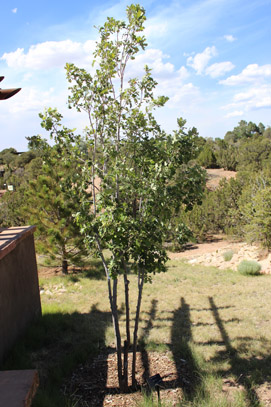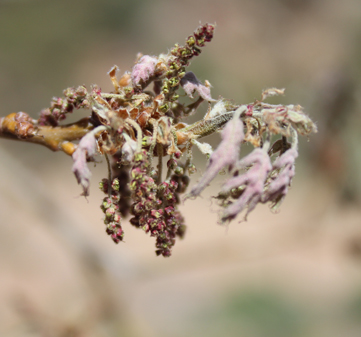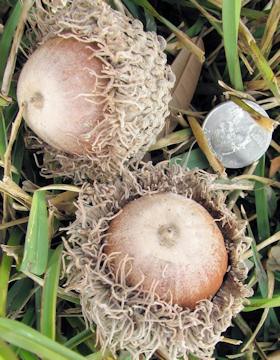Oak, Gambel - Quercus gambelii
 |
Description
"Common Name: Gambel oak Duration: Perennial Nativity: Native Lifeform: Tree Wetland Status: UPL General: Usually a tree that can reach 12 m in height, the bark is longitudinally fissured and light gray, younger twigs can be reddish brown and gray. Leaves: Deeply lobed 2-4 per side, the overall leaf is more elliptic in outline 4-17 cm long, 3-12 cm wide, 1-2 times as long as wide, thinly pubescent below, pubescent to subglabrous above, deciduous at the end of summer. The apex is rounded and the leaf is lustrous green above and strongly veined below. Flowers: Staminate aments with reduced perianth parts, 4-12 stamens; pistillate flowers solitary or in clusters of 2-3; inferior ovary. Fruits: The acorns are 1.5-2.5 cm long, solitary to clustered in 2 or 3, the cupule is hemispheric 8-12 mm long and both are less than 2 cm wide. Ecology: Found in forests, generally in association with ponderosa pine at higher elevations from 4,000-10,000 ft (1219-3048 m), flowers in April-June. Distribution: Ranges across the intermountain west to Wyoming and south into northern Mexico. Notes: The gently lobed margins are distinctive among the oaks in the region. It is also the most clearly associated species with higher elevation forests. Horrible hybridizer! Ethnobotany: The nuts were used as food, as ceremonial emetics, as an analgesic for pain, as a crude Viagra, it was ground into meal, eaten raw, stored, boiled, made into mush and flour. The wood was used as fuelwood, for furniture, other building materials, toys, ceremonial items, and other household implements. Etymology: Quercus is the classical Latin word for oak, thought to be derived from Celtic quer, fine, and cuez, tree, while gambelii is named for William Gambel. (SEINet)
Oak, Chinkapin - Quercus muehlenbergii
Description
"Quercus muehlenbergii, commonly called Chinkapin (or Chinquapin) oak, is a medium sized deciduous oak of the white oak group that typically grows 40-60’ (less frequently to 80’) tall with an open globular crown. It is native to central and eastern North America where it is typically found on dry upland sites often in rocky, alkaline soils. Insignificant monoecious yellowish-green flowers in separate male and female catkins appear in spring as the leaves emerge. Fruits are small oval acorns (to 3/4” long), with scaly cups that extend to approximately 1/2 the acorn length. Acorns are valued food for a variety of wildlife. Narrow, oblong-lanceolate, shiny green leaves (4-7” long) have coarse marginal teeth. Leaves somewhat resemble the leaves of chestnut (Castanea) whose nut is sometimes called a chinquapin, hence the common name of this oak whose acorn is sweet and edible. Also sometimes commonly called yellow chestnut oak. Fall color is variable, but usually undistinguished shades of yellow and brown.
Genus name comes from the classical Latin name for oak trees.
Specific epithet honors Gotthilf Henry Ernest Muhlenberg, 18-19th century Lutheran minister-botanist from Pennsylvania." (Missouri Botanical Garden)
Oak, Texas Red - Quercus buckleyi
 |
 |
Fall |
Flowers |
Description
"Quercus buckleyi, commonly known as Texas red oak or Buckley's oak, is a species of flowering plant in the beech family.[4][5]It is endemic to the southern Great Plains of the United States (Oklahoma and Texas).[6]
Quercus buckleyi is smaller and more likely to be multi-trunked than its close relative, the Shumard oak. The two species are interfertile, and hybrids are common along a line from Dallas to San Antonio. Texas red oak usually is 30 to 50 feet (9 to 15 meters) tall at maturity, and seldom reaches a height of more than 75 feet (23 meters).[7]
Quercus buckleyi was formerly known as Quercus texana but under botanical rules of priority, that name properly refers to Nuttall's oak.[3] This has led to much confusion.[7][8]
Quercus buckleyi is a highly regarded ornamental and shade tree. In autumn the leaves turn vivid red and orange." (Wikipedia)
"Southwestern native. Oval, irregular crown when young. Upright rounded to spreading shape in maturity. Leaves are medium green with lighter veining, deeply-lobed with toothy edges. Strong red to orange autumn color. Catkin flowers are insignificant. Acorns are a food source for wildlife. Litter from leaf drop. Synonym: Quercus texana." (Southern Nevada Water Authority)
Oak, Bur - Quercus macrocarpa
(Mossycup oak, Mossycup white oak)
 |
Acorns |
Description
"Quercus macrocarpa, the bur oak, sometimes spelled burr oak, is a species of oak in the white oak section Quercus sect. Quercus, native to North America in the eastern and central United States and eastern and central Canada. This plant is also called mossycup oak and mossycup white oak.
Quercus macrocarpa is widespread in the Atlantic coastal plain from New Brunswick to North Carolina, west as far as Alberta, eastern Montana, Wyoming, and northeastern New Mexico. The vast majority of the populations are found in the eastern Great Plains, the Mississippi/Missouri/Ohio Valley, and the Great Lakes region.[3]" (Wikipedia)